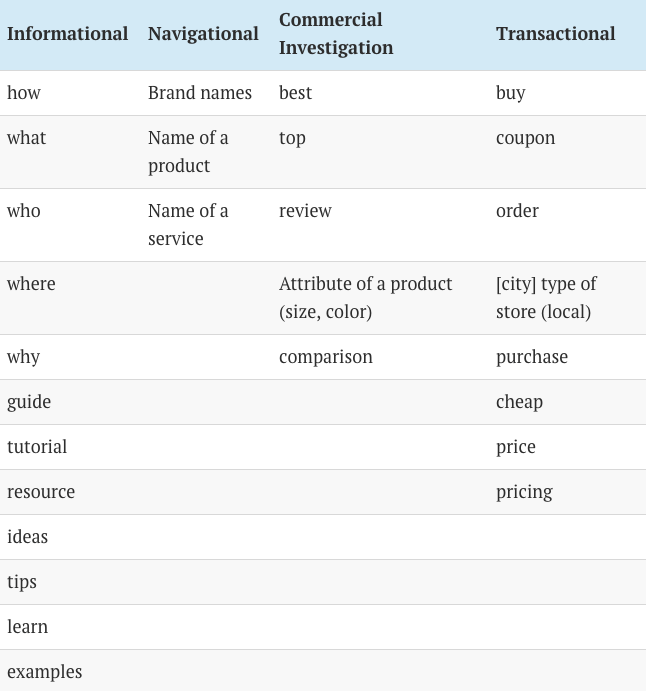With that in mind, this post will show you what search intent is, provide examples of search intent in practice, and provide advice on how to attract visitors through search intent-centric content.
What is search intent?
Search intent is the why behind a search query. In other words, why did the person make this search? Do they want to learn something? Are they looking to make a purchase? Or, are they looking for a particular website?
Understanding the intention behind a search helps you create content that better matches that person’s needs.
Why Is Search Intent Important?
Google has a specific algorithm that takes search intent into consideration when delivering search results.
If you fail to understand search intent, you risk delivering the wrong information to searchers. Let’s say that someone searches “how to buy a house” and you answer with “the best homes in my city.” It’s unlikely that you will be able to show up in the results because you didn’t actually answer their question.
This means that your content won’t rank (and therefore you won’t get any traffic). You also risk losing credibility as a source because you failed to deliver on your promise (i.e., how to buy a house).
The four types of search intent
1. Informational
The searcher is looking for information. This might be an answer to a simple question like “who is the president of the United States?”. Or something that requires a longer and more in-depth answer like “how does the blockchain work?” However, not all informational searches are formulated as questions.
Examples of informational searches:
- How to tie shoelaces
- How to change car oil
- What is a Content Delivery Network (CDN)
- Peanut butter and jelly sandwich recipe
- What time does Target close?
2. Navigational
The searcher has an exact brand or website in mind. They don’t need to see a list of brands that sell peanut butter and jelly sandwiches. They just want to go directly to the specific website they know will have what they want. Sometimes there can be some ambiguity with navigational searches, but generally speaking, you don’t need to worry about it if people are clicking through to your site.
You can consider optimizing for navigational intent by making your website easier to navigate, so it’s easier for people to find what they’re looking for. However, this should not be confused with commercial search intent, where someone wants to purchase an item from you, as opposed to searching for your brand name specifically.
3. Transactional
The searcher is looking to make a purchase. They’re in buying mode. Most likely, they already know what they want to buy. They’re looking for a place to buy it from.
Examples of transactional searches:
- where to buy running shoes near me
- galaxy s7 edge case amazon
- hotel deals in singapore
- car rental Changi airport
4. Commercial investigation
The searcher is in the market for a specific product or service but has yet to make a final decision on which solution is right for them. They’re most likely looking for reviews and comparisons. They’re still weighing up their options.
Examples of commercial investigation searches:
- Best all-in-one printers for home use
- Which camera is best for travel blogging?
- Compare car insurance companies in my area
How to infer search intent
Search intent often is obvious from the wording of the query itself. For example, take the keyword “buy bitcoin.” It’s clear that the searcher is in the market to buy some cryptocurrency (transactional). On the other hand, someone searching for “how to tie a tie” is looking for an answer (informational).
In other cases, however, search intent isn’t so obvious. This might be because there are multiple reasons a person might search for a particular term. Take “best credit cards,” for example. A person searching for this term could be looking for information about which credit card offers the best rewards or benefits. Or they could be looking to compare credit cards with the best APRs or find out which credit card is best for rebuilding their credit score.
Here are some keyword “modifiers” that typically indicate a certain type of search intent:

How to optimize for search intent

The type of content you create should be dictated by search intent.
If the keyword has informational intent, write a blog post. If it has transactional intent, create a product page. You get the gist.
But are things really this simple? Well, yes and no.
In order to truly optimize for search intent, we need delve deeper and analyze the SERPs in more detail.
Here’s how to do that, step by step:
Step 1 : Look at the SERP
When you search for a keyword, take a look at the results and try to understand what Google is trying to show you. Analyze each result separately and pay attention to its title and meta description.
Here’s an example:
Once you’ve done this for a few keywords, you should start to see patterns appearing. For example, if the majority of results on the first page are product pages, then there’s a good chance that Google is looking for products to show in response to that query. The same goes for category pages, services pages, blog posts or any other type of content. The most common pattern will be the one Google is trying to display when someone searches that keyword.
Step 2. Make sure your content aligns with the “3 C’s of search intent”
Now that you know your chosen keyword is sound (i.e., has clear search intent), your next task is to analyze the search results for what we like to call, “the 3 C’s of search intent.”
- Content type
- Content format
- Content angle
1. Content Type
This refers to the overall “type” of content in the search results, and is usually one of the following:
- Blog post. For example: “Best cat food.”
- Product page. For example: “Buy cat food online.”
- Category page. For example: “Healthy cat food brands.”
- Landing page. For example: “Best cat toys for indoor cats.”
2. Content Format
The content format of the top-ranking pages.
This refers to the “format” of the top-ranking pages. Some common formats include:
- “How-to” guides
- Step-by-step tutorials
- List posts
- Opinion pieces
- Reviews
- Comparisons
There are a lot of different formats, but these should give you an idea of what to look out for.
3. Content Angle
This refers to the unique selling point of the top-ranking posts and pages and provides insight into what searchers value when making this particular search.
For example, if we look at the search results for “how to make pancakes,” we can see a few different but similar angles in the results.
- How To Make Fluffy American Pancakes
- How To Make Easy Pancakes
- The Best Basic Pancake Recipe
- Easy Homemade Pancake Recipe from Scratch
- Simple Fluffy Buttermilk Pancakes (5 Ingredients)
- How To Make Pancakes (Easy Recipe)
Final Thought

People search for what they want. It’s as simple as that. So if you can determine what they want to find and develop content that delights or answers those needs, you’ll be in a far better position than if your site delivers poor-quality content or doesn’t answer the searcher’s question. And remember, it’s not just about giving them what they ask for – your content also has to be high-quality and interesting too. Get contact with Neu Entity as your Marketing Agency partner
Let’s Talk!
If what you see here is relevant for you and can help you grow your business or organisation, we’d love to discuss further with you. Drop us a message or schedule an appointment with us.
